Chapter 10
Week 3: Social Content—Text, Photos, Audio, and Video
This next chapter and the one that follows, “Week 4: Social Content—Ratings, Reviews, and Recommendations,” and “Week 5: Social Interactions,” are all about the content that people create and share on the social web. This includes content that relates to your product, service, and brand. In this chapter, you’re going to look at blogs, pictures, videos, and podcasts and at the tools people use to produce and publish them. For now, these tools are mostly free, and interruptive online advertising—whether sidebar ads earning money for a blogger or placed ads offsetting the cost of the publishing platform itself—remains the primary business model. Part of your decision in using these tools is whether or not you want third-party advertising appearing alongside your original content, so this is where the chapter starts.
Chapter Contents
- Advertising and the Social Web
- The Main Points
Advertising and the Social Web
It is worth noting that the majority of social networks and social media publishing tools share a common business model: Generate an audience and sell advertising, including formats ranging from display ads to sponsored content to paid articles. There is an interesting irony worth noting here: The social web and the basic supported consumerist behaviors of sharing and comparing in order to vet advertising claims are being paid for by more advertising!
As you develop your plan, be certain that you are clear about the difference between traditional advertising on the social web—buying display ad space on Facebook or a placement on Twitter—and actual social participation—for example, implementing a customer support forum or ideation platform like Starbucks’ My Starbucks Idea.
A new business model is coming. The conversations and media contributions powering leading social media sites aren’t being directly monetized—nor are the acts of creating them. Instead, it’s the impact of the conversation on the purchase funnel and the technique through which you can join the conversations, learn from them, and build your brand. In this chapter we will explore how you can join the social conversation through various types of social media.
Presented in the following sections are the core content media types, built up initially around consumer-generated media and now expanded to include the multimedia content that you can create. Media types covered include blogs—with a special section on corporate blogs—as well as microblogs, photo and video sharing, and podcasting.
Monday: Explore Corporate Blogs
One of the easiest entries onto the social web—and into the use of social media—is through a blog. No matter what your motivation or point of view, you have every right to create a blog. I mention this because blogging is one of the areas where a company-sponsored effort can be really effective, provided, of course, that you fully disclose the company connection. Think about it from a customer’s perspective. The blog, properly identified and actively used (by you), creates a great channel through which you can tell customers what you’re doing and invite them to share their thoughts. It’s a simple, easy, low-cost approach to social media.
Of course, this assumes that you are OK with whatever it is that people say: You really can’t control the conversation on a blog other than through the limited enforcement of profanity bans or similar basic and well-established policies.
The Internet interprets censorship as damage and routes around it.
—John Gilmore, 1993
In fact, you don’t even want to control it. The point of the blog is to create a free exchange so that you can learn what your customers (and potential customers) like, dislike, value, and so on. This drives directly back to the points I made in earlier chapters: The social web is a place where you can learn about current issues and opportunities and where you can enlist the brains and emotions of your audience to help you develop your next-generation products and services. The basic requirements for beginning an effective blogging strategy are covered in the following sections. For more information about blogging, use Google and search for “how to blog.” You’ll find plenty of good help.
Transparency
Transparency is key to an effective corporate blog. First, you want the benefits of your blogging program to accrue to you, and the best way to do that is by making sure that your name is on it. Second, by being transparent you prevent the kinds of very negative publicity that will (not can but will) occur in response to the use of fake or paid blogs. With regard to paid blogs—a program through which you offer a payment or incentive in exchange for a blogger writing about you—this is a strategy to avoid. It will almost always result in a disclosure problem.
Tip: Friends don’t let friends pay bloggers.
Despite your best intentions, it still happens that a paid blogger fails to adequately disclose having been paid. Even when disclosed, commercial bloggers naturally seek to increase the value of their reputations, and so there is always a tension around disclosure when bloggers are paid by those they blog about, just as there would be if a newspaper reporter was paid by the firm being written about in a newspaper article. The result is that a forthright disclosure is often weakened or skipped altogether. When outed, a predictable blowback results. In that event, you will inevitably be held accountable. After all, who do you suppose your critics will point the finger at: you and your flagship brand or “Joe up-until-now-unknown-blogger”?
So what’s the right way to engage bloggers? Instead of paying them, help them out. Make sure that anything you send them is interesting and related to what they write about. Bloggers typically cover a specific area, and it’s a mistake to think of them as an organic substitute to PR Newswire. In the next section I cover listening. Listening—and in particular using a listening tool like BuzzStream that actually shows you who the important bloggers are in your market space—is the basis of effectively engaging on the social web.
Paid Blogging Gone Bad
The social web is quite effective when it comes to outing social campaigns that are not all what they may appear to be. A blog-based campaign such as Wal-Mart’s “Wal-Marting across America” that I referenced in Chapter 2, “The Marketer’s Dilemma,” is but one well-known blow-up.
Unfortunately, there are many others. These types of campaigns—in which what appears to be neutral content is actually sponsored—occur more often than you might think and by firms from whom you’d expect better. Cisco’s “Human Network” campaign was called out for a lack of transparency by Jeff Jarvis. HP’s compensation to bloggers won them a finalist position at a SXSW panel featuring the worst social media campaigns.
Understand that these are great brands with smart partners. If they can make this mistake, it’s worth pointing out again here: Don’t pay bloggers. If the blogger happens to be your own employee or contractor, that’s fine. Just be sure that you always disclose the relationship. Don’t create blogs that are less than 100 percent transparent.
Ironically, the practice of slipping sponsored content into neutral channels—for example, creating what appears to be news (and paying for it) isn’t new. In August 2008, Advertising Age reported that the sixth annual MS&L Marketing Management Survey found that 19 percent of the CMOs and marketing directors interviewed said they had purchased advertising in return for a news story. Moreover, 53 percent said “the marketing industry as a whole is not following ethical guidelines in the new-media realm.” Social web citizens expect a higher standard.
Willingness to Listen
From a marketing perspective, listening is a critical skill. This sounds so obvious, yet for many advertisers, listening is rarely the focus of the day-to-day work. Instead, the focus is on “telling,” on making potential buyers aware of what you have to offer.
On the social web listening pays big dividends. Not only does listening—expressed, for example, through your blog posts that make an actual reference to what one of your readers said—help build a relationship with your audience, but it also provides you with a rich stream of information that you can use to gain a competitive advantage. Sam Lawrence, founding CMO for Jive Software and co-founder and CEO of Crushpath, talks about the importance of listening:
Marketing needs to be released from being solely responsible for changing perceptions or driving leads. They should be enabling the organization to make meaningful, positive customer experiences and connections. This may seem like a subtle shift but when Marketing can feel comfortable becoming listeners instead of blasting sales messages, dramatic change ensues.
The change that Sam notes, moving from talker, from spreader of messages, to listener is a key insight into getting the most from the social web. Again, think back to what you worked on in Chapter 6, “Week 3: Touchpoint Analysis.” Your marketing efforts on the social web are just one part of an overall, integrated marketing effort. If you only use the social web to listen—and then apply what you learn internally to make a better product or create a more delightful customer experience—how would that change things?
Operations and Marketing
You may wonder how the combination of operations and marketing within your organization relates to blogging. Building on the preceding discussion about being a better listener, consider that one of the most effective uses of a corporate blog is as a channel to effect internal change, in the pursuit of a better customer experience. Properly implemented, a blog opens a channel between your customers and the people in your organization who can translate what is being posted into a better customer experience. The improved customer experience—whether moving from bad to good or from good to great—will surely drive a stronger and more beneficial presence on the social web.
How do you leverage a strengthened presence on the social web? By linking marketing and operations, and by making sure that what your customers are telling you is being translated into action.
Willingness to Act
In the end, it’s the translation into action that separates the winners from the also-rans. Social media—precisely because it is listener-oriented in a way that is dramatically different from traditional outreach channels—will surely raise the visibility of opportunities and challenges within your organization to new levels. While it may make good headlines for social media advocates, turning up the heat without a program to tap that feedback is a recipe for disaster. The goal is to use social media to drive business objectives and increase the effectiveness of your entire organization. Before proposing the addition of a social media effort, and in particular using a channel such as a blog that invites direct feedback, be sure to connect with and gain the buy-in of your operations, IT, and HR teams. They are key constituents in the successful implementation of social media.
Monday’s One-Hour Exercise
Today you’ll be reviewing a set of corporate blogs, looking at how they are used, and getting a sense for the time commitment required to maintain them. I’ve picked three blogs from CMOs at firms involved in social media and from the companies themselves. The fourth blog you’ll get to look at—TED Blog—is included simply to give you something to think about.
The CMO blogs will give you an idea of how you can create a blog associated with the work that you do and then use this to build relationships with colleagues and customers. This type of blog can be really helpful in increasing your social media knowledge and will provide you with solid experience in using the blogging channel as a content producer. The corporate blogs selected are simple, straightforward examples. Some of the corporate blogs are handled and managed internally, while others have been implemented through the use of a white-label platform—in this case, Salesforce.com.
Tip: Wikipedia provides two excellent resources if you’re interested in learning about setting up a blog. The first Wikipedia entry listed provides a comprehensive listing of blogging software. The second provides tips and typical uses in business and includes a reference to a Technorati list of top-rated corporate blogs.
Blogging software: http://en.wikipedia.org/wiki/Blogging_software
Corporate blogging: http://en.wikipedia.org/wiki/Corporate_blog
There are additional resources and professionals available online as well. Using Google, search for “corporate blogging.”
Tip: A set of worksheets covering this week’s exercises can be found in Appendix A, “Worksheets.” In addition to these printed worksheets, you can download electronic copies and access related resources at the website accompanying this book. Complete information regarding these resources and the website is included in Appendix A.
Today you’re going to spend an hour reviewing the selected blogs. You’ll then develop a plan for including this channel—if applicable—in your social media marketing plan.
Note: These are active blogs serving current communities. Please do not leave test messages. If you see a post of interest, however, do participate. After all, that’s why they are there.
GoBigAlways
Created by Sam Lawrence, shown in Figure 10-1, this site is Sam’s GoBigAlways blog. Sam posts his thoughts on the development and application of social media, including the launch of Crushpath. Note especially the disclosure that Sam provides. Without this disclosure, the posts regarding Crushpath could be taken the wrong way, as an independent endorsement, for example, by an industry leader. Sam’s disclosure makes sure readers of his blog understand his personal interests as they apply to his posts.
About Me
Sam is an entrepreneur and angel investor. He’s currently co-founder and CEO of Crushpath—a different way for revenue generators to land business besides CRM. Previously, he was the founding CMO for Jive Software and pivoted the company from Discussion Forum vendor to the Social Business Software leader. He lives in San Francisco.
This kind of disclosure not only prevents any appearance of impropriety; it actually gives Sam license to talk about Jive. Sam’s credibility, therefore, transfers to the brand, just as the marketplace stature of Jive conveys a sense of expert status to Sam.
Figure 10-1: Sam Lawrence, Crushpath CEO, with the famed Enterprise Octopus

Bazaarvoice
http://www.bazaarvoice.com/blog/
The Bazaarvoice blog is a straightforward implementation of a corporate blog: Fully disclosed, fully transparent, and filled with useful information about Bazaarvoice and its key people, this blog is read by customers, potential customers, and, importantly, by the employees that power Bazaarvoice. Remember what I said about attracting and retaining the best talent? Here it is, in action.
Influence 3.0
From Kantar Media/Cymfony, Influence 3.0 covers a variety of issues related to implementing, analyzing, and measuring social media and its impact on business.
TED Blog
From the annual conference, TED Blog, shown in Figure 10-2, is a great series of thought-provoking posts by leading thinkers. Later this week, you’ll visit TED Talks podcast site. Caution: I listed this one last because otherwise you could end up spending your entire hour here. Don’t say I didn’t warn you.
As you review the blogs cited, consider the following:
- What is it that seems most useful about these examples?
- How is disclosure handled? How does disclosure strengthen the blog and its message?
- How often is new content posted? Which items posted generate the most comments (or the most passionate comments)?
- How does the company handle the discussion within the comments? Does the company participate?
- How could you use a blog as a part of your own marketing effort? Who would write it? Who would read it?
Figure 10-2: TED Blog
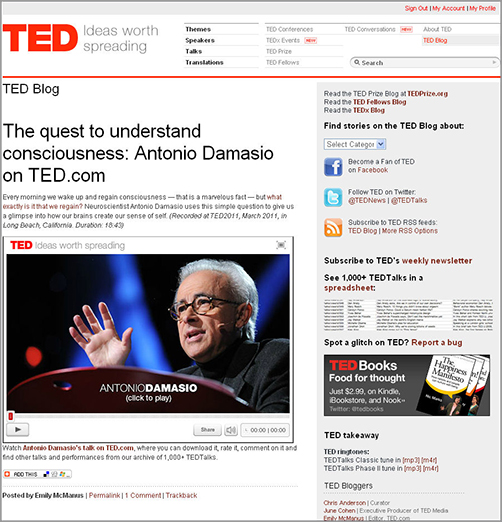
Monday’s Wrap-Up
Today you reviewed three distinct examples of blogs related to marketing. Sam’s personal blog is used as a sounding board for his ideas and often features the products of his employer. Bazaarvoice’s blog is an internally supported platform that features the ideas of its key people along with announcements of interest to current and potential customers. Cymfony’s Influence 3.0 blog and TED Blog are solid examples of the use of blogging as a way to extend your thoughts and then validate them based on comments and reader participation. These are the kinds of ways that you can implement and use blogging as an introduction into social media.
Tuesday: Experience Microblogs
Twitter is the gateway drug to social media.
—Jim Storer, principal/founder at The Community Roundtable and former senior director, Social Media Strategy, Mzinga
My friend Steve Golab, cofounder of the interactive firm FG SQUARED, spotted this on Twitter. At first, I didn’t quite get it—I was new to Twitter at the time. For the record, I was something like the 13 millionth person to sign up for Twitter, proving that you don’t have to be an early adopter to get this stuff. Flash forward: I have been using social tools and networks for a few years; most networks struck me as useful but also possessing a distinct learning curve. Beyond the social norms and mastery of activities particular to Facebook, Google+, LinkedIn, and other specific sites, the interfaces are generally complex, but then so are real-life social interactions and conventions. Take Facebook as an example: You have an inbox, notifications, applications, timeline-style status updates, and more. This isn’t a knock—simply a recognition that, like in Microsoft Word, there is a lot there whether you use it all or not.
Not so with Twitter, shown in Figure 10-3. An input box, an Update button, 140 characters of your choice … and the whole world. I learned to use Twitter with relative ease. Seeing the value took a bit longer, but eventually I got it. Now I’m hooked.
With microblogs you post quick, short bursts of text or video, as others around you do the same. You offer a new post, and others comment. You see something interesting, and you share it with your followers. Twitter has all the complexity of walking into a room full of people at a party. You start by listening, and then you introduce yourself and get involved. Microblogs boil social networking down to its most essential elements: a post, a comment, and an indication of relationships. You choose to listen (or not) to people around you, and they do the same with you.
Twitter-like communication has now been built into most social networking tools, whether they are personal (for example, Facebook adopted Twitter’s casual posting style, and Foursquare provides a very similar “what’s happening (here) right now” service. Inside the enterprise, Salesforce.com’s Chatter, Yammer, and the tools built into Socialtext and Socialcast are all derivatives of Twitter. More and more, what people are doing right now matters.
Figure 10-3: Twitter
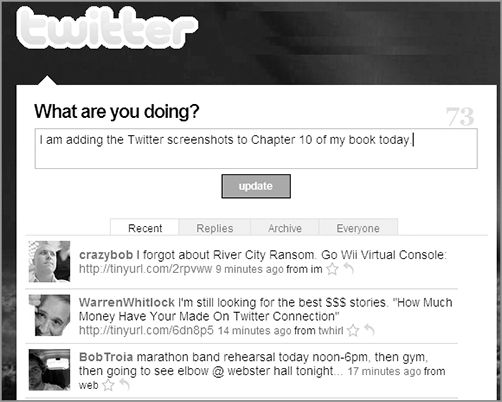
Twitaholic: Quantifying the Chatter
If you’d like a quick look into the numbers of people using Twitter, look no further than Twitaholic (http://twitaholic.com). You’ll find the most active members in terms of posts (tweets), friends, and followers. You’ll also see the order in which members joined Twitter. For example, Twitter co-founder Biz Stone is member 13; Robert Scoble is roughly member 13,000, and I am roughly member 13,000,000.
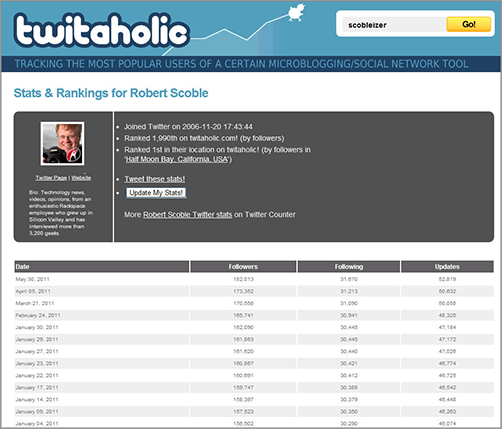
Using a microblog for marketing is pretty simple—but like anything on the social web, there are rules, and there are consequences for not following them. Spamming will land you in hot water in minutes. For example, while it may be tempting, do not randomly contact people to build a list of followers, only to then turn around and post about yourself and your products. This is considered spam and, as noted, will quickly get you (at best) shunned or (at worst) get your account closed. Above all, do not buy followers. Yes, you can do it. No, it won’t help you establish true influence on the social web.
Twitter: Can I Do Business Here?
Without a doubt, yes. Through the end of 2009, Mashable reported that Dell had total sales of $6.5 million directly through its commerce-related Twitter accounts. OK, you say, “But $6 million on a base of $60 billion is nothing.” I’d counter that with, “And if someone gave you $6 million, you’d take it, right?” Take a look at @DellOutlet and @DellSmBizOffers. Could your business or organization be doing the same thing?
Expanding the ease of use of microblogs beyond text, applications and external services that plug into Twitter to support photo and video uploads as well as social platforms like Posterous, Tumblr, and Google+ make it simple to add pictures and videos to posts. Google+ even takes it a step further. If you enable the feature, Google+ offers an automatic upload of all of the images you capture with your Android tablet or smartphone, making them readily available for selectively publicizing and sharing within your Google+ circles. You can see my Google+/Picasa integration in Figure 10-4.
Figure 10-4: Adding photos on Google+
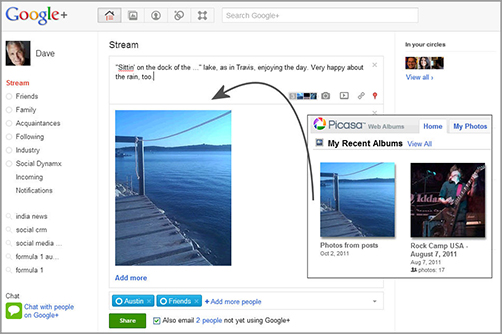
Like other forms of social media, microblogs can be used for listening (brand intelligence), talking (outreach), or both. Forward-thinking firms like Boingo, Comcast, Dell, and United Airlines monitor Twitter, looking for references to their brand and then resolving customer issues within their social care teams. They can spot problems, which is useful in and of itself. Even more important, though, is that they quickly spot problems being talked about in a highly connected social environment. Once a problem is identified, they can contact the originator of the post and work toward resolving it, which also often occurs in public. Because microblogs are a real-time stream, the problem can often be identified and resolved before the negative conversation has a chance to spread to more permanent media like a blog, a forum, or (gasp!) an article or a book.
What Are You Doing Right Now?
Long story short, I got busted for answering that question on Twitter. In the first edition of this book I described Twitter as a “business tool,” which of course it is. But it’s way more than that, as I discovered when one reader brought to my attention the difference between what I’d said (Twitter is a “business tool,” to be used for retweeting industry articles, for example) and what I was actually posting (“Flying down Indira Gandhi Marg, New Delhi in an autorickshaw listening to Volbeat on my @SkullCandy FMJ’s”). Here’s the deal: If your Twitter handle is your brand name, stick to business and serve your followers. If your Twitter handle is your actual name, just serve your followers. If you want to talk about work, and your followers expect that, super. If you want to mix in some personal comments (and vice versa), watch for follower comments and post accordingly. If you are using Twitter for purely personal posting—aka, life-streaming—then post away, but do stop occasionally to ask yourself, “If your mother or your boss or your future client saw this post, would that person want to follow you on Twitter or connect with you on LinkedIn?”
Tuesday’s One-Hour Exercise
If you’re not using Twitter or a similar microblogging service, today you’re going to start. In the first part of this exercise, the assumption is that you’ll be using Twitter: You can adapt it to any microblogging tool you prefer.
Tip: In addition to Twitter, check out FriendFeed, Identi.ca, Jaiku, and Plurk. Look also at the internal microblogging tools like Chatter, Yammer, and Socialcast. You’ll find a complete listing of these services in Appendix B, “Additional Social Media Resources.” If you’re new to Twitter, Twitter Handbook (http://www.twitterhandbook.com) provides a great (free!) starting point.
Today, as you explore the suggested microblogs, consider the following:
- What seems most useful about microblogs?
- How are marketers using these tools?
- Compared with a blog, do microblogs feel more like communities than publishing tools?
- How could you use a microblog as a part of your own marketing effort? Who would update it? Who would use it?
If you haven’t signed up, you can do so by going to http://twitter.com. It will take you about 30 seconds.
After you sign up, you’ll be wondering what to do; this is normal. Search for friends using the built-in search feature, or let Twitter have a peek at your contacts list. The first thing you’ll notice is the public timeline and a whole stream of posts marked “less than 5 seconds ago.” Ignore this. It’s like standing in the middle of the Astrodome and trying to make sense of the individual conversations of the 50,000 people seated around you, made worse by the fact that on Twitter there are between a hundred and a thousand times as many people talking!
Having signed up at Twitter (or your preferred microblog), go to your Home tab. Search for the following:
- Boingo
- ComcastCares
- Dell
- United
- Zappos
- While you’re at it, search for me! (evansdave)
Click Follow on anything that looks interesting (which is to say, any of the first five), and you’ll soon start seeing a stream (for example, news updates) coming from these sources.
You can send email invites to friends or search for friends or colleagues who are using Twitter already. Find them, and follow them. You can add your own thoughts to the conversation by simply typing in the box and clicking Update. Pretty soon you’ll be part of what’s happening on Twitter.
So what you can do? Post a question. Post a thought. Post an event. As a marketer, keep a couple of things in mind, though. Other than on the public timeline, which, as noted, is not generally looked at, your generic posts will be visible only to those who have opted to follow you. If you post only about yourself and what you are selling, expect your list of followers to decline, all the way to zero.
Tuesday’s Wrap-Up
As with any social tool, the first step in learning to use it as a marketer is learning to use it as a participant. Get to know the rules, and take the time to understand why this particular channel exists. Look at what other businesses are doing. What seems acceptable? Follow their lead. Look especially at the kinds of actions that irritate people or get members ticked off—or kicked off. Don’t do those things. Because communities—collections of those followed and their followers—are built voluntarily, you can actually use microblogs, just as with blogs, for business and promotional activities. If people don’t want hear from you, they’ll simply stop following you or block you. Good conduct will minimize that.
Tip: Go easy on posting until you’ve found your groove. With 140 characters you may be thinking, “What could go wrong?” Get too carried away, and you’ll find out.
Wednesday: Consider Photo and Video Sharing
As the saying goes, “A picture is worth a thousand words.” So it is with social content: A photo or video can convey precise meaning and can engage an audience in ways that words alone sometimes fail to do. This is particularly important when you consider the multitasking scan-oriented consumption of digital content. Adding visual elements transforms the conveyance of a message into a quick, scan-friendly experience.
What are the kinds of things that you can do—as a marketer—with visual content? For starters, you can simply show your products—although this is among the least effective applications of social media. To make the most of any social channel, start by creating content that involves your audience rather than simply talking at them. Then, extend this by integrating your content through cross-channel campaigns that tap your other social efforts. Don’t look now, but later in the chapter you’ll see an example of this type of integration in “Featured Case: Brooklyn Museum of Art.”
Got TV? You can use online channels—which are often more lenient with regard to their acceptance standards—to present a spot that has been made expressly for the Web. For example, you may have a special cut that you might not have been able to show on TV but that online would generate favorable, appropriate exposure. Photos and video are also helpful when offering instructional or similar content that shows a complex operation or otherwise illustrates written documentation. In that case, a photo or video that you make yourself can be perfect. When you do it in such a way that it can be passed around or easily picked up and dropped into a forum or blog by your customers, you further increase the likelihood that your message will be spread around.
When using social channels, you really want to leverage the social component and that usually means audience participation. Creating what is essentially a catalog isn’t necessarily a social experience. Look back at the list of channels available to you: TV, print, catalogs, and direct mail, to name a few. You already have plenty of places to show and tell about your product or service. Don’t shortchange the social web by viewing it as one more talk outlet. Instead, use the combination of visual elements and audience participation to show your product or service in action. Let people see what other people are doing. Note here as well that I’m not talking about showing models or other artificial representations. Encourage real people, using content that they made, to spread the word about your products and services. Tap your evangelists.
Beyond the portrayal of your products and services (by you or by someone else), you can also use visual content to document events, parties, openings, cause-related events, or product launches—all of which are things that you participate in at the brand level. This seems obvious, but it is still the minority of marketers who go beyond a single photo on the website of, for example, the CEO cutting a ribbon as next year’s model is rolled out. How about uploading the entire set of pictures from the launch party to Facebook or Google+? What about uploading a video of runners crossing the line at a company-sponsored charity run and then tying that to your corporate blog or community newsletter to bring out the stories of the people involved? That is the social stuff that builds an audience.
Yes, you need to think this out in advance; you may need release forms, for example, to show an event video publicly. But it’s worth the effort. If there was a video of you crossing the line after running a marathon, wouldn’t you send the link to your friends? Most people would, and a simple Tell-a-Friend button would make this very easy. The value of your campaign or event sponsorship goes up as more people view the event and hear directly from the people who participated in it. This is the social part of social media and ironically the part that many marketers miss.
Wednesday’s One-Hour Exercise
Today you’ll look at some examples of professional and user-generated content that feature pictures and videos of products in use, instructional tips, and examples of the kinds of content that consumers create to share with others. As you work through these examples, keep in mind that none of this social content exists alone: It is all supported in multiple other channels.
For today’s exercise, do the following:
- Go to the sites indicated and search for the suggested terms. Review each item, and think about how it is being used and who is viewing it.
- Having looked at the examples, imagine two social content programs—built around videos or photos—that you could add to your marketing efforts, and then write down these ideas. For example, consider how you might use video to show your customers (and potential customers) how to get more out of what you offer. For another, consider how you would encourage your current customers to create visual content that could be shared in order to create a positive lift element for your brand, product, or service.
YouTube
YouTube is an ideal channel for posting video content that illustrates the use of a product as well as content that actually is the product. With a high reach and near-universal accessibility, YouTube is a great channel that is, frankly, underused for marketing and customer service.
Search for: Instructional Video
Take a look at the Khan Academy and the way in which it has extended both its presence and relevance. The Khan Academy offers over 2,600 videos on subjects ranging from physics and math to history and finance. With over 80,000,000 lessons delivered, the Khan Academy has created a forward-looking educational platform that naturally leverages the power of the social web.
Search for: DIY Projects
Next, search for The Home Depot–sponsored “How to Replace a Bath Faucet” (about 170,000 views) and “Joe & Joe Backdrop Project” (about 35,000 views). The “Faucet” video will strike a chord with any homeowner who’s ever thought about upgrading a lavatory fixture, and the “Backdrop” video has great information that is useful for any amateur photographer wanting to take better pictures in a home studio. Both of these videos have solid viewing stats and, not surprisingly, were designed for specific customers. One of the things to keep in mind when considering the production of a video series, or encouraging or facilitating actual consumer-generated social content, is the importance of knowing exactly who your customers are and what they need.
How to Replace a Bath Faucet - The Home Depot
http://www.youtube.com/watch?v=BxrJkd2VbVs
Joe & Joe Backdrop Project
http://www.youtube.com/watch?v=oJrH2Dj8oGc
Search for: UTI Fiesta Contest
Universal Technical Institute (UTI) offers a number of videos at its YouTube site: This particular exercise looks at the videos highlighting the 2011 UTI Ford Fiesta, a specially built model of the standard Ford Fiesta. The first video to review features entrepreneur Neil Tjin, co-founder of the auto-enthusiast “Tjin Edition” program. Neil introduces the 2011 Tjin Edition Ford Fiesta.
The second video is a commercial. Although it may seem odd—this is a book about social media, not traditional ads, right?—I included it because it’s a great example of integration (this same spot could appear in a number of formats) as well as the smart use of YouTube as a traditional channel for video advertisements.
Neil Tjin, 2011 UTI Ford Fiesta
http://www.youtube.com/watch?v=2cL1mXLwhVQ
UTI Ford Fiesta YouTube Sweepstakes Ad
http://www.youtube.com/watch?v=IURnFWYVqWg
As a final example, look at this short instructional video for a niche, low-cost product that really benefits from a video. In this case, the product is a new type of inline skate. This has been included simply to establish that you don’t need fancy, professionally produced content to be effective. This casual video (viewed now about a quarter of a million times) shows an easy way to get the hang of these skates—thereby encouraging mastery among new riders—and shows the proper use of basic safety equipment as well.
Freeline Skates
http://www.youtube.com/watch?v=fgh0sqGacnU
Flickr
Turning to photos, take a look at Flickr. While Flickr is not a suitable platform for outright commercial use, there is a “social media + business” application of Flickr that is worth noting.
Search Terms: The Home Depot Kids Workshops, and Whole Foods Market
Here you’ll find photos of projects as well as photos taken on Family Days at The Home Depot, where kids are invited to build basic woodworking projects. In this example, the permitted use of cameras in the store results in parents posting images of the kinds of family-oriented activities that typify these Home Depot construction days. Because these are posted to personal Flickr accounts, it is fairly safe to assume that they are being shared among family and friends, furthering the spread of the very positive aspect of The Home Depot brand.
This kind of content creation forms an important component of a social media program. By encouraging customers to create and share content that portrays your business in a favorable setting, you are creating content that can offset the content created by your detractors.
Think back to Chapter 7, “Week 4: Influence and Measurement,” and the Net Promoter Score: Your online reputation is determined by the difference in the number of people talking positively versus those talking negatively. Without this positive content resulting from Family Days at The Home Depot, the instructional content, and the contests, the negative efforts of the detractors would dominate the conversation. By participating in the social aspects of your brand as it is built online, you can prevent that from happening. Again, you can’t prevent detractors; they have as much right to the social web as you do. You can, however, by participating yourself, prevent them from being the sole social voice of your brand.
In Figure 10-5, you can see photos taken in various Whole Foods Markets and then posted online. I include this example here because it’s worth thinking about the policies that your own firm may have when it comes to photography or video. Whole Foods Market does not allow photography inside its stores without explicit permission. At the same time, it’s quite likely given some of the comments that the people who took the photos were unaware that the policy existed before taking the photo.
Figure 10-5: Whole Foods Market on Flickr

I’m not suggesting that merchants like Whole Foods—which go to great lengths to create an incredible customer experience—adopt and post policies like that for the Area 51 military base, shown in Figure 10-6. The point is instead that it is becoming an experiential disconnect—think here in terms of touchpoints—for customers who are very used to creating and sharing content online to be barred from doing the same thing in real life. When cameras are built into phones, and uploading takes one click, people want to document experiences. What people see, people share. Being told “no” works against your social media efforts.
Figure 10-6: Area 51 photo policy

The reality is that Flickr lists well in excess of 10,000 photos uploaded and tagged “Whole Foods.” Many of them are interior shots, and many of the comments include phrases to the effect “as I was taking this shot, I heard a voice heading my way saying something about the prohibition of photos.” Individual policies are, of course, a matter for each firm to decide on its own. Suffice it is to say, though, that with over 10,000 photos at one photo-sharing site alone along with a number of comments that refer negatively to the photo policy, discouraging photos and the sharing of the Whole Foods experience is not likely to make the most of social media and what the social web can do. The Whole Foods experience is built on multiple touchpoints. For me personally, it’s the passion of the associates, something that can’t be photographed or easily copied—and not the way the oranges are stacked—that make the Whole Foods experience what it is. Even more important, though, is that policies that prevent the sharing of experiences tip the content on the social web in favor of your competitors and detractors. Unlike your loyal customers—who typically respect your wishes and put the camera away—your competitors and detractors are going to go into stealth mode and take the pictures anyway. The social conversation will be, as a result, decidedly one-sided.
Wednesday’s Wrap-Up
Today you looked at videos and photos and added to your plan options with both an internal program and a consumer-generated program. Your emerging plan options now include a blog and/or microblog used for outreach, issue resolution, or product research and visual components that directly involve your customers in the beneficial conveyance of your message.
As you consider selected social components for your marketing program, another aspect of social media is likely emerging: It’s about smaller numbers added up, rather than larger numbers done all at once. Consider The Home Depot videos; most are in the 100,000 views range. In contrast to TV, few are in the millions range. This is one of the reasons why your creative agency or media buyers may be slow to suggest social programs. They are used to—and set up for—buying (and getting paid for) large amounts of exposure. There is nothing wrong with that, and large-exposure campaigns are still an important aspect of an overall marketing effort for most marketers. It is, however, something to keep in mind as you move toward implementation.
Where traditional media is often centered on awareness or perception, social media is about influence. If you gain real influence, one person at a time, and that person tells three people, your social efforts significantly enhance your awareness and perception efforts. Think back to the purchase funnel and the social feedback cycle and as well to your use of TV to build awareness, or paid search near the point of sale to drive closure. Social media—active in the consideration phase—is about adding credible influence, suggestion, persuasion, tips, and new uses—the things that a potential customer will find most helpful and, therefore, the things that are most likely to create an additional use (purchase) or help a fence sitter make a decision favorable to you. Both of these assume that the social content is positive; if the content is negative—recall the Kryptonite bike lock videos (search YouTube if you’ve never seen them)—then the result can be exactly the opposite of what you really want. In the end, social media is an adjunct, an aid, another tool that is part of your marketing toolbox. Like any other single tool, it is best used in combination—as an integrated element—with the tools used in the balance of your campaigns.
Understanding the contributory impact of social media—the difference between reaching a million people who may or may not be thinking about repainting the living room this weekend versus reaching the thousand who actually have this task on their to-do list right now—is critical not only to getting the most out of the social web but also to successfully selling your plan. Where a traditional campaign can be presented in terms of millions reached, a social campaign is typically presented in terms of a thousand influenced. It will fall to you to make the case for the smaller, highly targeted social efforts that effectively convey your brand by allowing potential customers a direct and participative role in shaping and sharing a collective message about your product or service. Your social campaign—the false notion of going viral aside—is best built on small pieces that connect current customers directly with potential customers. These small pieces serve to amplify, extend, or bring credibility to your larger awareness campaigns. Added up, these smaller social campaigns (in comparison to the millions of eyeballs purchased via traditional media) are a significantly forceful component in your overall marketing program. If you couldn’t interrupt, these messages would still get through.
Thursday: Experience Audio and Video Podcasting
Quick: What’s the difference between an audio or video clip and a podcast? The answer is “Nothing, unless you count how it’s actually delivered and consumed,” which of course on the social web turns out make all the difference. The real importance of podcasting isn’t the clip itself but rather how it is delivered. To be clear, the content does matter. The content itself has to do something for someone—it has to make your audience smarter, or make someone laugh, or illustrate a point. Note, however, that those are the same rules that apply to any marketing content that is expected to perform well, on the social web or anyplace else.
This point about delivery and consumption is again a fundamental indicator of the way in which the social web changes the rules of engagement for marketing and again an example of the opportunity created for a savvy marketer. Start with a quick look at what makes a podcast a podcast. A podcast is, after all, nothing more than a sequenced, subscription-based delivery container for content, generally audio or video. Podcasting is, at its core, an extension of blogging. And like blogging, podcasting is another application of RSS. Just like with a blog, your “readers” (here, listeners or viewers) subscribe to your podcast. Just like with blogging, you publish regular posts, although in this case they are called “episodes.” Finally, just like with blogging, new episodes are automatically delivered to designated players—typically a computer, an iPod (from whence the name originates) or phone, or similar handheld device. Once the episodes are delivered, those who subscribe to your podcast can listen to or watch the episodes you’ve produced.
Podcasting: Numbers Don’t Lie
If you’ve never listened to a podcast, you may be tempted to dismiss this medium as a fringe channel. It’s not. Not only is it popular; it’s also highly effective. Consider the following:
- Advertising in podcasts and online shows has a threefold ad effectiveness increase over traditional online video and a sevenfold effectiveness increase over television. Unaided ad awareness across two years of studies was 68 percent compared to industry benchmarks of 21 percent for streaming video and 10 percent for television.
- Embedded ad placements are more effective than pre-roll across a range of audio and video formats, including varying spot lengths (10, 15, or 30 seconds) and across show formats (produced and host-read).
- Advertising in podcasts and online shows is effective in moving users from awareness to consideration to purchase. There is a 73 percent average increase in likelihood to use/buy versus a control group.
- Podcast advertising leads to a more favorable opinion of an advertiser after hearing or seeing an ad. Sixty-nine percent of those podcast listeners surveyed had a more favorable view of the advertisers following ad exposure.
Source: Podtrac-TNS Advertising Effectiveness Studies, 2006–2008
With podcasting, beyond the content it’s all about delivery. It’s about giving your audience the absolute choice of where, when, and how to consume your content. Embedding a clip into a website fails on this count: It requires a visit to the website! If someone is riding on a mountain bike or hiking in Muir Woods, they aren’t going to simultaneously visit your website. By allowing the people you want to reach to take your message to the place, time, and appropriate device of their choosing, you must make your message accessible on an entirely different level. It means giving someone the ability to listen to an executive thought-leadership series while walking on the beach. It means making riding the train, working out at the gym, or sitting in the airport (not that you ever do that) productive. In short, it means giving valuable gifts to your audience: the gifts of time, place, and choice.
By giving control over to your audience and then empowering them to set the terms of engagement with your message, it signals that you are on their side, that you are a partner, and that you fundamentally understand the pressures and challenges presented in a multitask-oriented, information-driven world. If it sounds like I’ve gone off the deep end here, stop. Put the book down and continue through the rest of your day, but keep what you’ve just read in the back of your mind. Count the number of times today that you say or think, “OK, hold on, let me finish this and I’ll get back to you.” Count the number of times that two or more priority events compete for your attention. Podcasting—and specifically giving your audience the choice over where, when, and which device—empowers your audience to shift the point of consumption of your message to a place where full engagement can actually occur. As a marketer, isn’t that what you really want? A great example of podcasting used effectively in marketing is Susan Bratton’s “Personal Life Media,” shown in Figure 10-7.
Figure 10-7: Personal Life Media
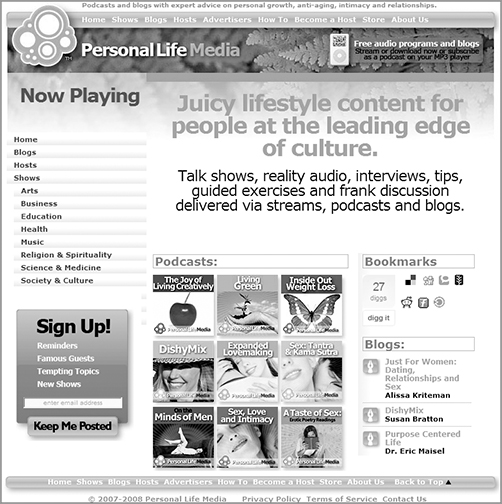
Featured Case: Cancer InfoLink and The Prostate Net Podcast Series
I first met Dr. Arnon Krongrad working with The Prostate Net (http://www.prostatenet.org/), an outreach program created by prostate cancer survivor Virgil Simons to provide men with information about the treatment available and the importance of talking with their doctors. Virgil created a podcast series for just this purpose. I was interviewing Dr. Krongrad about laparoscopic—meaning “surgery without cutting you open”—radical prostatectomy (removal of the prostate). Dr. Krongrad pioneered the use of laparoscopic radical prostatectomy after witnessing firsthand the needless blood loss and painful complications of traditional, open prostatectomy. The Krongrad Institute is the world’s only private program devoted exclusively to laparoscopic prostate surgery (http://www.laprp.com/).
Six months after we had completed the interview and published the podcast, I got an email from Dr. Krongrad inviting me to review his newest project, the community extension of Cancer InfoLink (http://prostatecancerinfolink.ning.com/). Dr. Krongrad had used the Ning social platform to create a discussion community around the outreach and awareness work that he is doing in conjunction with the podcast series.
Based on the initiative of Virgil and Dr. Krongrad, simple tools like podcasting and the free Ning community platform have been put to use educating men and their families about the issues of prostate cancer. The podcast allows men—who typically suppress emotions like fear, hurt, and pain—to educate themselves in relative privacy. The community groups on Cancer InfoLink give survivors a forum where they can talk with each other about beating cancer and talk with men who are just now recognizing that they too need to take action in order to do the same. These are powerful examples of social media and testament to just how accessible and impactful this form of communication has become.
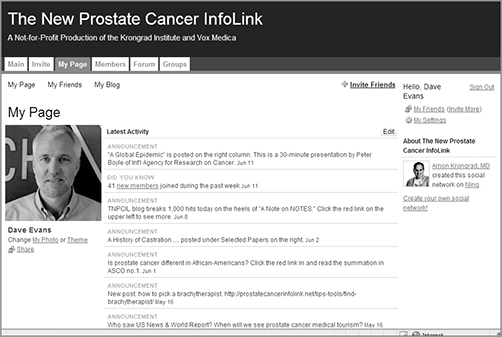
Thursday’s One-Hour Exercise
Today you’re going to spend an hour listening to and watching selected podcasts and then picking a few for subscription. In this sense, you’ll be doing part of this exercise today—sampling—and part of the exercise later when you actually listen to and view the subscriptions. To satisfy the immediate gratification needs of a contemporary audience, one of the podcasting best practices is to provide your audience with a sampling option that satisfies this need for immediacy. You’ll start the exercise in the same way that your audience will typically experience your podcast program: by reviewing the descriptions of the podcast and then clicking the Listen Now button or link. Once you’ve found something that you like, subscribe to it. If you have a mobile device that can accept podcasts, set up your subscription to push the episodes to that device.
No Podcast-Capable Device?
If you don’t have a mobile audio device, now would be a good time to get one. According to Podtrac, about 60 percent of all podcasts are listened to on a portable device, compared with 40 percent on a PC. The Apple iPod is by far the easiest to use. Shop around and look for a model that suits you. If you’re on a budget, look for deals on last year’s model. Do you have an iPod-savvy daughter? Offer to buy her a new one in exchange for her old one and a quick tutorial. Getting a decent podcast-capable device empowers you to take the content with you. This in turn allows you to explore the places where content consumption makes sense for you—and in so doing discover or imagine the places that your audience may choose to do the same. Try it. It’s a great exercise and one that is likely to change your view of your mobile device and of the potential venues for marketing content delivered via podcasting.
Here is a starting set of podcasts that you can sample. Some are personal interest; others are pure business. Note how each is monetized and how each can be used to carry a persuasive message. With some, the content is the vehicle that carries a relatively traditional advertising play; they use pre- or post-roll ads or video overlays. In others—like the series on men’s health from The Prostate Net—the message itself is the focus: The marketing objective is to bring information to men and persuade them to pay attention to their own health.
Already listening to or watching podcasts? If you’re already a podcast consumer, then you can either do the exercise mentioned previously—hey, you may find something new that you enjoy—or you can follow along, using your own podcasts in place of those suggested.
As you work through the exercise, note the following:
- The role of the description: How well were you able to judge the likely relevance of the content before you listened to it?
- The role of the “listen now” feature: Did this help you make your decision?
- The presence or absence of “send to a friend.”
- The presence or absence of a subscription option. Remember, if you can’t subscribe, it’s not a podcast. (It may still be great content, but it’s not a podcast.)
- The overall quality of the podcast—how does it compare with other podcasts? With TV? What difference—if any—did this make? How good is “good enough?”
- What is the most important aspect of the podcast? For example, is it quality? Content? Accessibility?
Suggested podcasts:
Personal Life Media/Living Green
http://blogs.personallifemedia.com/living-green/
IBM Syndicated Podcast Feeds
http://www.ibm.com/ibm/syndication/podcasts/
Shell Safety Podcast
http://www.shell.com/home/content/environment_society/safety/safety_podcast/
Slate’s Podcasting Guide
http://www.slate.com/articles/podcasts/podcasts/2005/07/slates_podcasting_guide.html
TED Talks
http://www.ted.com/index.php/talks
Thursday’s Wrap-Up
Today you explored podcasts and, hopefully, found and subscribed to a couple of them. More important, you gained a first-hand experience with a medium that is purpose built for time- and place-shifting, in other words, the ability to take your content wherever you go and enjoy it when it makes sense for you. If you’re new to RSS subscriptions, as the podcasts you’ve signed up for begin arriving you’ll get a real sense for the empowerment that choice over “when, where, and what” provides. If you’re already subscribed to podcasts (and are consuming them on a mobile device), you’ve already experienced this.
By providing content in a portable format, you effectively increase not only the productivity of your audience (especially so with audio, which is built for multitasking) but also the likelihood that your content will be listened to in an environment with lower background noise (in both the physical and mental senses). That can be a significant factor in engagement, retention, and message reception. As a bonus, because the content can be easily shared, you’ve set up your audience to refer what they find useful among themselves, further adding to the effectiveness of your overall marketing program.
Friday: Create Your Social Media Marketing Plan
This week you covered social content—media created by you and your customers for the specific purpose of sharing uses, insights, and experiences among those interested. Applications include learning more, understanding purchase or use-related nuances, perhaps extending the product or service you offer in ways you hadn’t thought of, and a lot more.
Now it’s time to put this to work, and that means adding these elements to your developing social media marketing plan. As you work through today’s exercise and the continued development of your plan, keep in mind that none of this social content exists alone. In Figure 10-8, look at the range of content—a blog, Twitter presence, video, photos, and event calendars—that powers the comprehensive online presence for the Brooklyn Museum.
Figure 10-8: Brooklyn Museum: comprehensive social media involvement
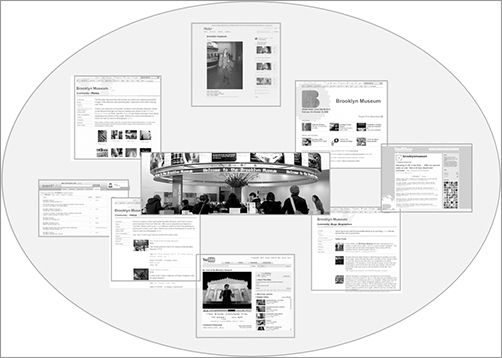
Friday’s One-Hour Exercise
To start off today’s exercise, gather together the notes you made this week about video, photos, and podcasting. Review them, and then think through the following thought starters:
- What are the most challenging aspects of your current marketing program, in terms of overcoming objections, driving new uses, or driving additional purchases?
- Which of these lend themselves to assistance via video, photos, or a podcast?
- Which of these lend themselves to the kinds of content that your customers would create? Which would be best if you made the content and then gave it to your existing customers to share or comment on?
- What are the most promising video, photo, or podcast applications that would add depth to the blog you created in the prior chapter?
Friday’s Wrap-Up
You now have a solid start on a comprehensive marketing plan. Your social components are intended to complement—not replace—traditional media, direct mail, online media, and other marketing elements that you are using. Last week you stepped into social networks. You saw how to create an effective marketing presence using the tools that are available to quickly add “social” to your current marketing effort.
As an example of how all of the channels you’ve seen come together to create a solid social campaign, go beyond Figure 10-8 and check out—online—the work of the Brooklyn Museum. The Brooklyn Museum combines a website, blog, Twitter, YouTube, Flickr (along with an excellent photography policy!), and more to support its overall online presence and to connect the online audience to the museum itself. Note that this is not an expensive implementation of social media–based marketing; instead, it’s just straightforward, smart work that fits perfectly into the overall museum marketing program.
Featured Case: Brooklyn Museum of Art
The Brooklyn Museum of Art has created an outstanding social presence for itself through the smart use of social media. Building off the main website, which includes a blog, directory, and similar information resources, the museum’s media team has added a presence on Twitter that is used to disseminate short bits of information. YouTube and Flickr are used as well. YouTube has videos of museum exhibits and promotions, and Flickr is filled with images taken by visitors and uploaded to the museum’s Flickr group. Eventful, a social media–based calendar tool, lists all of the events coming up, along with a running commentary by people who have visited in the past. All in all, it adds to a solid presence and one with multiple connection points. The museum’s overall social presence is shown in Figure 10-8.
Chapter 10 added social content—text (posts), photos, and videos that bring the life into the social networks covered in Chapter 9, “Week 2: Social Platforms.” Chapter 10 covered the following points:
- Blogs are an effective, easy way to build a credible social presence. Be prepared to deal with direct, public customer feedback.
- Microblogs are casual forums that can be used to quickly create a following.
- Audio and video content can be used to extend text-based information. When created by your customers, video can convey to them a real sense of participation in the brand.
- Podcasting gives those interested in what you have to say the ability to choose where, when, and on what device they will listen.
- Social media is one of the many tools that you have available when developing and extending your business presence. Like your entire toolbox, the more that your social components interlock with each other and with your traditional efforts, the better.
